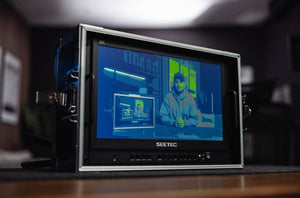Utilising False Colour On Set With The SEETEC ATEM 156-CO
Would you like to utilise the false colour feature during filming on set?
In the realm of film making and videography, the tools at our disposal are as diverse as the stories we seek to tell. Among these tools lies the SEETEC ATEM 156 CO, a versatile monitor that not only displays images but also offers an array of features to enhance the creative process. One such feature that often goes underutilised but holds immense potential is the False Colour feature.
False Colour is a visualisation tool that assigns different colours to different luminescence levels within an image. While it may sound complex, its application can significantly aid filmmakers and cinematographers in achieving the desired look and maintaining consistent exposure throughout their projects. Let's delve deeper into how to utilise the False Colour feature on the SEETEC ATEM 156 CO to elevate your film making endeavours:

Understanding False Colour:
Before delving into its practical applications, it's essential to grasp the basics of False Colour. Essentially, False Colour represents various brightness levels within an image using a colour spectrum. This spectrum typically ranges from cool to warm hues, each corresponding to a specific luminescence value. For instance, pure black might be represented as blue, while pure white could appear as red.
Exposure Control:
:One of the primary applications of False Colour is aiding in exposure control. By utilising False Colour, filmmakers can quickly identify areas of their frame that are over or underexposed. This is particularly useful when shooting in challenging lighting conditions where traditional exposure meters might falter. Instead of relying solely on histograms or zebras, False Colour offers a more intuitive and visual representation of exposure levels.
Achieving Consistency:
Maintaining consistent exposure is crucial in film making, especially when shooting scenes across different locations or times of day. False Colour can serve as a reliable tool for ensuring this consistency by allowing filmmakers to match exposure levels precisely from shot to shot. By monitoring the colour representation of various elements within the frame, filmmakers can make quick adjustments to achieve uniformity throughout their project.
Creative Decision-Making:
Beyond exposure control, False Colour can also facilitate creative decision-making during the filming process. By analysing the distribution of colours within the frame, filmmakers can evaluate the overall tonal balance and make informed decisions regarding lighting setups and composition. Additionally, False Colour can help visualise the mood and atmosphere of a scene, guiding filmmakers in achieving the desired aesthetic.
Practical Implementation:
Utilising False Colour on the SEETEC ATEM 156 CO is straightforward and intuitive. Once enabled, False Colour overlays the colour spectrum onto the monitor's display, allowing filmmakers to assess exposure levels in real-time. By adjusting exposure settings on the camera or lighting equipment, filmmakers can observe changes in the False Colour representation and make immediate adjustments as needed.
Available in the UK with next day shipping
We're thrilled to announce that we now stock this powerhouse monitor at our High Wycombe warehouse, ready to be shipped to you at lightning speed. With its stunning display quality and an array of features including False Colour for precise exposure control, the SEETEC ATEM 156 CO is a must-have for filmmakers and videographers alike. Don't let long wait times hold you back—order now and experience the difference firsthand!

